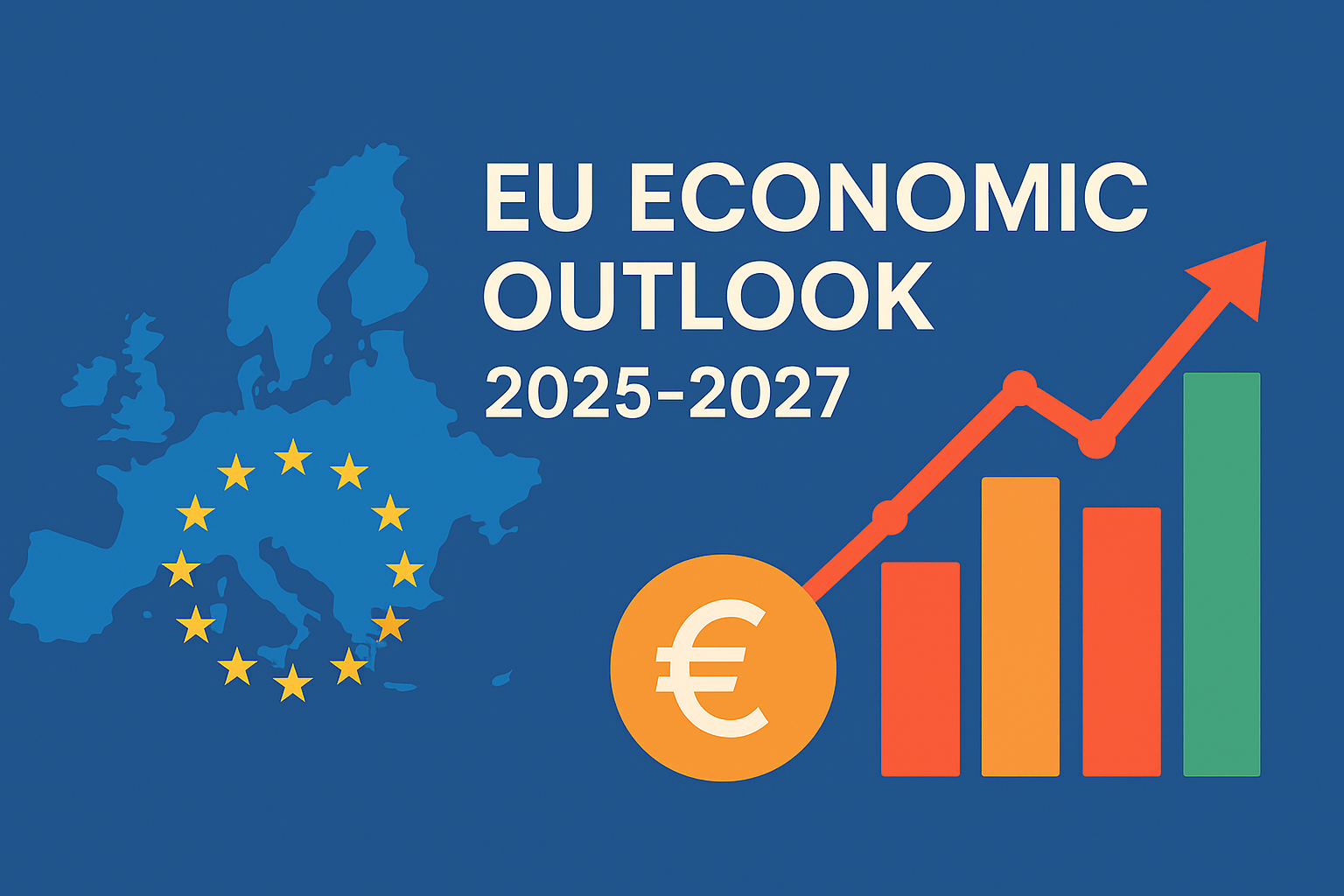Certainly. Below is the full English version of the EU Economic Outlook Report (2025–2027), written in the voice of a senior economist, incorporating country-level analysis and stress test scenarios, along with source citations.
🧭 Executive Summary
Between 2025 and 2027, the European Union enters a phase of cautious economic recovery. While pandemic-related imbalances are fading, the region continues to face three major structural risks: trade tensions (especially with the U.S.), geopolitical volatility (Middle East, Ukraine), and internal reform fatigue.
Three core economies—Germany, France, and Italy—are evolving unevenly. Germany faces structural stagnation, France experiences external headwinds, and Italy battles demographic and fiscal rigidity. This report delivers an integrated macroeconomic forecast, country-specific profiles, and scenario-based stress testing for policymakers and analysts.
Aggregate EU Economic Forecast (2025–2027)
| Year | Real GDP Growth (EU) | Euro Area | Inflation (Headline) | Policy Interest Rate |
|---|---|---|---|---|
| 2025 | 1.1% (EC) / 0.8% (IMF) | 0.9% (ECB) | 2.3% | 3.75% → easing toward 2.5% |
| 2026 | 1.5% (EC) / 1.2% (IMF) | 1.1% | 1.9% | Approaching neutral rate (1.9%) |
Sources:
- European Commission Spring Forecast 2025
- ECB Staff Projections (June 2025)
- IMF World Economic Outlook (April 2025)
🌍Country Analysis
Germany: Policy Pivot Amid Industrial Stagnation
- Growth: 2025: ~0.0–0.1%, 2026: ~1.0%, 2027: ~1.3% (ifo Institute)
- Headwinds: Structural decline in industrial output, high energy costs, low housing investment due to elevated mortgage rates
- Policy Shift: Chancellor Merz unveiled a €500B “Future Investment Fund” targeting defense, semiconductors, and green tech
France: Stable Domestic Demand vs. Export Headwinds
- Growth: 2025: 0.6%, 2026: 1.2% (INSEE)
- Inflation: ~1.0% (harmonized)
- Fiscal: Public deficit remains at 5.4% of GDP, limiting fiscal space for stimulus
- Exports: Contributing negatively to growth (–0.7 ppt in 2025)
Italy: Mild Recovery with Long-Term Demographic Constraints
- Growth: 2025: 0.6%, 2026: 0.8% (ISTAT, IMF)
- Challenges: Fast-aging population, pension burden, high public debt (~137% of GDP)
- Tailwinds: EU Recovery Fund investment, tourism rebound, digital infrastructure spending
Stress Test Scenarios (2025–2026)
| Scenario | Risk Assumptions | EU-Wide GDP Impact (Cumulative) | Country-Level Impact (Δ GDP) | Policy Response |
|---|---|---|---|---|
| Baseline | Moderate trade tensions, stable oil | –0.2 to –0.5 ppt | DE: –0.3 / FR: –0.2 / IT: –0.1 | Gradual rate cuts + selective stimulus |
| Adverse | U.S. tariffs + Mideast energy shock | –0.8 to –1.2 ppt | DE: –0.7 / FR: –0.5 / IT: –0.4 | EU fiscal coordination, ECB easing |
| Positive | EU–U.S. trade truce, geopolitical easing | +0.5 to +0.8 ppt | DE: +0.4 / FR: +0.3 / IT: +0.2 | Investment-led easing, labor reforms |
Structural Challenges and Strategic Recommendations
Capital Market Integration
The EU’s Capital Markets Union must accelerate to channel savings into growth sectors (e.g., green/AI), especially for SMEs and startups.
Labor Mobility & Demographics
High-skill migration policy and intra-EU labor mobility are essential to offset aging populations and regional disparities.
Fiscal Reform & Joint Investment Facilities
Shared fiscal tools (e.g., for defense, R&D, climate) could complement national budgets and ensure EU-wide resilience.
Conclusion: Stability at the Cost of Potential
From 2025 to 2027, the EU is expected to return to a “low-growth, moderate inflation” equilibrium, supported by cautious monetary easing and stable labor markets. However, risks remain elevated and the recovery lacks dynamism without deeper structural reforms.
To convert stability into sustained prosperity, the EU must focus on:
- Completing the internal market (capital, labor, energy)
- Germany–France fiscal leadership for EU-level investments
- Reform-driven growth in Italy and other structurally weaker economies
Only through a combination of integration, innovation, and investment can the EU strengthen its position in a multipolar global economy.
📚 References
- European Commission (2025)
- Spring Economic Forecast
https://economy-finance.ec.europa.eu/publications/spring-2025-economic-forecast_en
- Spring Economic Forecast
- ECB Staff Projections (June 2025)
https://www.ecb.europa.eu/pub/projections/html/index.en.html - IMF World Economic Outlook (April 2025)
https://www.imf.org/en/Publications/WEO/Issues/2025/04 - OECD Economic Outlook (Germany, France, Italy)
https://www.oecd.org/economic-outlook/ - ifo Institute (Germany)
https://www.ifo.de/en - INSEE (France)
https://www.insee.fr/en/statistiques - ISTAT (Italy)
https://www.istat.it/en - Reuters (June 2025)
- Germany: Merz €500B investment plan
- France economy at 0.6% growth
- Italy’s demographic crisis and policy response
- The Times (UK)
- ECB cuts policy rate to 2.5%
https://www.thetimes.co.uk/article/ecb-interest-rate-cut-2025
- ECB cuts policy rate to 2.5%


